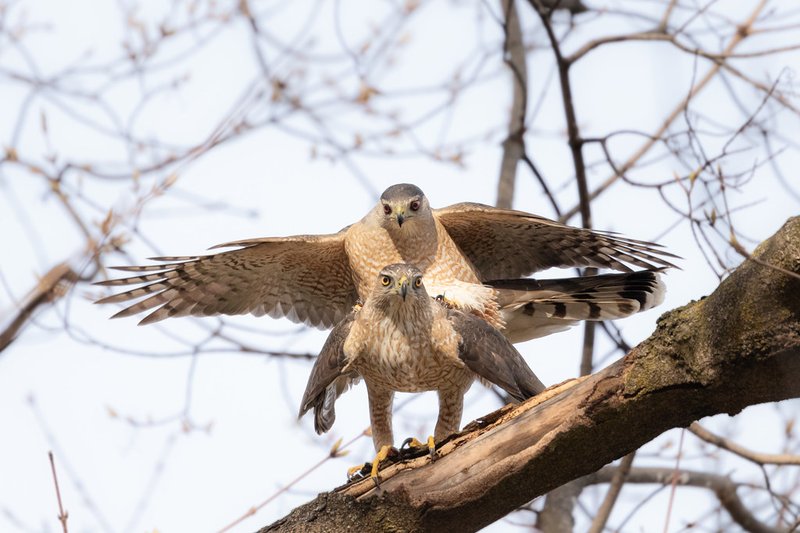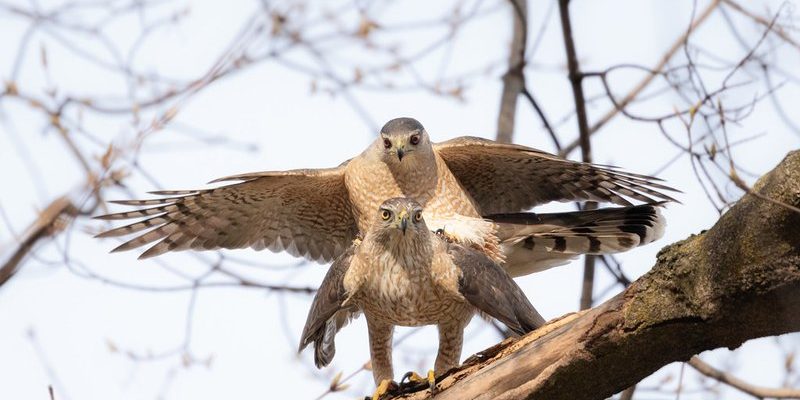
Imagine a couple taking a dance class together. At first, they’re tentative, but soon, they find their rhythm. Similarly, Cooper’s Hawks engage in captivating maneuvers that allow them to bond with their partners. In this article, we’ll dive deep into their courtship routines, mating behaviors, and how they raise their young, painting a picture for anyone curious about these intriguing raptors.
Understanding the Cooper’s Hawk
Before we delve into their romantic side, let’s get familiar with the Cooper’s Hawk. These birds are known for their sharp features and agile flight. With a wingspan of about 28 to 36 inches, they can typically be spotted gliding gracefully through the canopy of trees or quickly darting after their prey. They are named after the famous ornithologist William Cooper, but you might think of them as the ninja of the bird world—stealthy and agile.
These birds are a part of the Accipiter family, which consists of smaller, forest-dwelling hawks. They mainly hunt smaller birds, such as sparrows and doves, making them skilled predators. What’s fascinating is how their physical traits complement their hunting technique: their long tails and short rounded wings allow for swift, maneuverable flight in dense environments. You might say they have the perfect design for the kind of lifestyle they lead.
The Art of Courtship Displays
You might be wondering, how exactly do these hawks court one another? The courtship display of the Cooper’s Hawk is nothing short of a thrilling air show. During the breeding season, which typically begins in early spring, males engage in impressive aerial acrobatics to attract females. They soar, dive, and perform spiral stunts that showcase their agility.
One of the standout features of their courtship is the “sky dance.” The male will elevate into the sky, calling out in a series of whistles and barks. This vocalization is not just for show; it signals his presence and health to potential mates. As he performs this aerial ballet, he also showcases his strength, vitality, and impressive flying skills, which are all attractive traits to a female.
Interestingly enough, these displays are not solely for attracting a mate; they also reinforce the bond between the pair. Once a female chooses a male based on his performance, the two will often engage in tandem flights together, further solidifying their connection. It’s a beautiful process of finding harmony in their partnership.
Mating Behaviors: A Lifelong Bond
Once a pair of Cooper’s Hawks has formed a bond through their courtship rituals, they’re likely to mate for life. This is quite special in the bird world, where many species have less commitment. Mating occurs in mid to late spring; after a successful bond, the male will help the female by bringing her food and assisting in nest building.
Cooper’s Hawks prefer to nest in tall trees and often return to the same location year after year. They’ll create a nest using twigs, bark, and leaves, usually at a height of about 20 to 70 feet. During this time, the male plays a vital role in ensuring the nest is well-stocked with materials and food. You might liken this to a couple preparing their home before welcoming a new family member.
As they settle down, you can see their partnership in action as they communicate with subtle body language and vocalizations, ensuring both partners are in sync about their roles in raising their young. This bond is strengthened as they work together, showing the beauty of teamwork in the animal kingdom.
Building the Nest: Home Sweet Home
Now, what happens next in their story? Nesting is an essential phase for Cooper’s Hawks. After they’ve chosen a location, the female takes the lead in building their nest. Using sticks and other materials, she crafts a cozy home where they can lay their eggs. The male often fetches the materials, showing support and commitment.
Once the nest is complete, the female lays about 3 to 5 eggs. During this incubation period, which lasts approximately 30 to 36 days, the male continues his role as a provider, bringing food to the female while she keeps the eggs warm and safe. Can you imagine the level of trust they have built by this point? It’s a partnership that involves shared responsibilities and dedication to their future offspring.
After the eggs hatch, the young hawks, known as eaglets, will spend several weeks in the nest before they are ready to fledge. Both parents contribute to feeding the young, teaching them crucial survival skills that will prepare them for life outside the nest. Talk about teamwork!
Raising the Young: Family Dynamics
The journey doesn’t end once the eggs hatch. Raising young hawks is a major commitment for the Cooper’s pair. Once the eaglets are out of their shells, they rely completely on their parents for food and protection. The adult hawks take turns hunting, often bringing back small birds or other prey to nourish their growing brood.
Interestingly, you might see the parents exhibiting protective behaviors. If a potential threat, like a larger bird or even a human, comes near, they will not hesitate to dive and swoop in defense of their nest. This protective instinct is a testament to their dedication. Here’s the thing: not only do they have to hunt for themselves, but they also ensure their young are safe and well-fed.
As the young hawks grow stronger, they begin to practice their flying skills. You can imagine the sense of pride the parents must feel as they watch their eaglets take their first flights. It’s a moment of transition, marking the young hawks’ first steps toward independence. This nurturing phase often lasts for about 6-8 weeks until the fledglings are fully capable of hunting on their own.
The Importance of Courtship and Mating Rituals
You might be wondering: why are these courtship and mating rituals essential for Cooper’s Hawks? Well, these behaviors play a crucial role in ensuring the continuation of the species. The aerial displays attract healthy partners, while the teamwork involved in nesting and raising young increases the survival rate of the offspring.
Additionally, the bonding process strengthens the pair’s relationship, allowing them to work efficiently together in hunting and rearing their young. Healthy partnerships lead to stronger, more resilient offspring that can thrive in the wild.
In a broader sense, understanding these rituals can help bird enthusiasts appreciate the complexities of nature and the intricate social dynamics within species. It’s a reminder of how interconnected life is and how critical these practices are for survival.
Wrapping Up the Courtship Story
The courtship and mating rituals of the Cooper’s Hawk are not just a series of acts; they represent a beautiful dance of connection, trust, and teamwork. From the mesmerizing aerial displays to the dedicated efforts in raising their young, these behaviors show the depth of their relationships.
So, the next time you spot a Cooper’s Hawk soaring through the sky, take a moment to appreciate that there’s more to its story than meets the eye. It’s not just a bird of prey; it’s part of an intricate narrative of love, partnership, and family life in the wild.
In the grand tapestry of nature, the Cooper’s Hawk stands out as a symbol of resilience and cooperation, reminding us of the beauty of our own connections.

